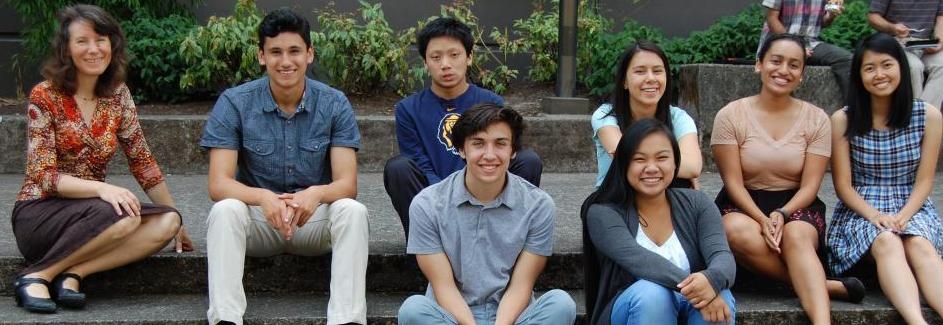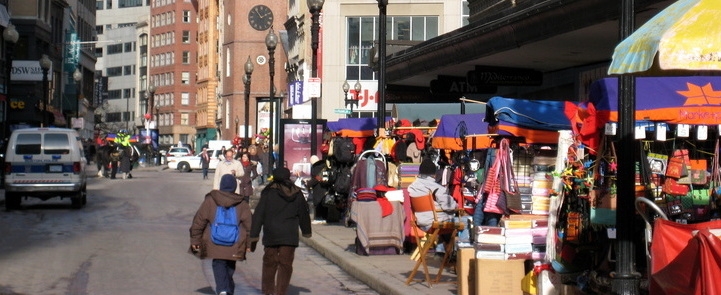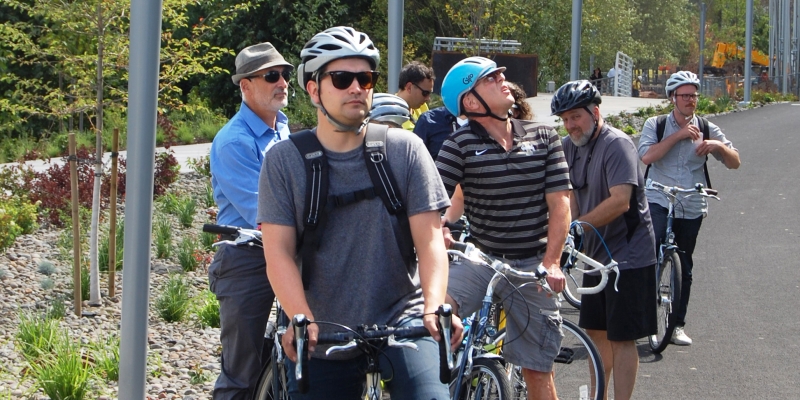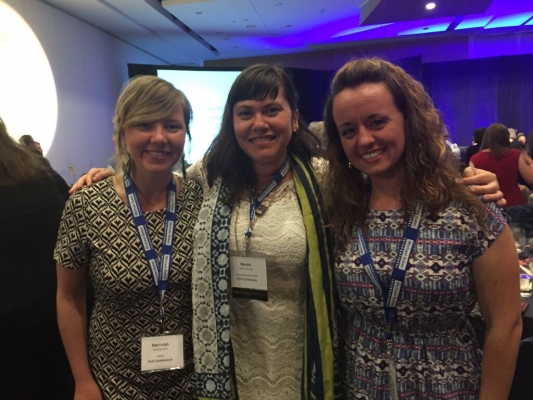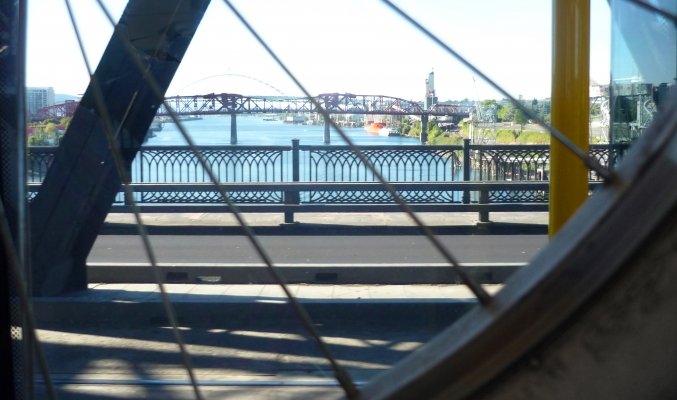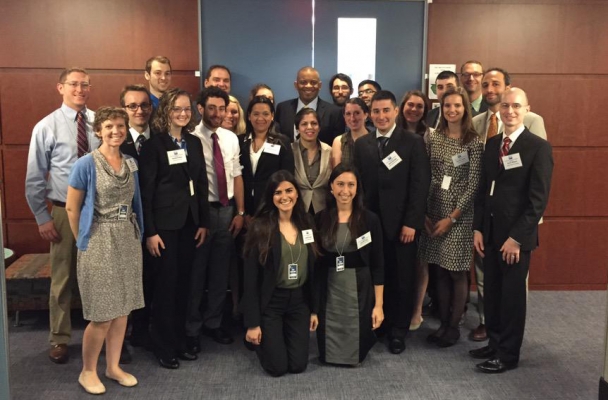Seven dedicated students spent their summer days in TREC’s offices at PSU this year, working to transform the Bike-Ped Portal project from a dream into a reality.
TREC already houses Portal, a vast collection of Portland-area traffic and transit data, and NITC researchers saw a need for a database on the national scale for non-motorized transportation modes.
Research associate Krista Nordback launched the NITC pooled-fund project, Online Non-motorized Traffic Count Archive, with co-investigator Kristen Tufte in the spring of 2014. A year ago, Bike-Ped Portal was little more than an idea.
Now it contains roughly four million individual records of bicycle, pedestrian and even equestrian movements in five states.
High school interns Jolene Liu, Tomas Ramirez, Tara Sengupta, Gautum Singh, Kim Le, Max Fajardo and Kimberly Kuhn worked full time for weeks in order to convert piles of unsorted documentation into usable formats.
Nordback engaged the team of interns through Saturday Academy, a...
Read moreA NITC research project from Portland State University introduces a method of cleaning up land use data, for use in improved transportation models.
Transportation and land use are closely interdependent. Considerable work is underway, in Oregon and elsewhere, to develop models that integrate the two.
Planners creating these models often spend the bulk of their time preparing data on the various land uses. Many times the data, gathered from diverse sources, is incomplete and requires the planner to find missing information to fill in the gaps.
In fields outside of transportation, there have been considerable advances in techniques to do this. Data-mining and machine-learning techniques have been developed, for example, to systematically detect fraud in credit data, reconcile medical records and clean up information on the web.
In the transportation modeling community, by contrast, most efforts to tackle the problem are tied to a specific model system and a chosen study area. Few have produced reusable tools for processing land use data.
Liming Wang, lead investigator of the project Continuous Data Integration for Land Use and Transportation Planning and Modeling, offers such reusable...
Read moreOn creating civic engagement, driving density and sharing a stage with the 'funniest person on earth'
Our cities reflect how we choose to live. Increasingly, we choose to live alone.
Eric Klinenberg spent seven years researching people who live alone for his book “Going Solo: The Extraordinary Rise and Surprising Appeal of Living Alone.” Klinenberg will discuss the implications for the future of transportation as keynote speaker for the Transportation and Communities Summit on Monday, Sept. 15.
> More information on the Transportation and Communities Summit
> Register now!
Klinenberg, a sociology professor at New York University, came to the topic after an earlier investigation into isolation. Instead of a problem, however, he found the sort of vitality that drives civic participation.
People who live alone, Klinenberg said, make cities vibrant places by nourishing the “social infrastructure”: the places and institutions that support people’s public lives.
“When countries invest in public amenities, including transit, they make it easier for...
Comprehensive Bikeway Design 1.0, a popular summer workshop offered by the Initiative for Bicycle and Pedestrian Innovation (IBPI), wrapped up to a successful conclusion last week.
Hau Hagedorn, director of the IBPI, has seen the annual workshop grow into a one-of-a-kind training opportunity for bicycle and pedestrian professionals.
“The course is comprehensive. It isn't just about bikeway design. It's about everything a city can do to become more bike-friendly, including policies that support cycling and land uses that encourage active transportation,” Hagedorn said.
With 10 participants from six states, this year’s workshop helped further the IBPI’s goal of expanding America’s bicycle and pedestrian infrastructure to encourage healthier, more sustainable forms of transportation. The participants came from a diversity of disciplines including community and bicycle planning, academic research and political leadership, and traveled from as far away as Pennsylvania to visit Portland’s bicycle culture.
“I think it reaffirms that this is a unique opportunity, for people to come and see what has been done in Portland. This didn't happen overnight. It gives a good idea of what can be done in other places,” Hagedorn said.
The five-day instructional course began on Sunday, July 26, with a tour of...
Read moreMillennials prefer walking over driving by a substantially wider margin than any other generation, according to a new poll conducted by the National Association of Realtors and TREC, the Transportation Research and Education Center at Portland State University.
The 2015 National Community and Transportation Preference Survey found that millennials, those aged 18 to 34, prefer walking as a mode of transportation by 12 percentage points over driving. Millennials are also shown to prefer living in attached housing, living within walking distance of shops and restaurants, and having a short commute, and are the most likely age group to make use of public transportation.
The poll also found that millennials show a stronger preference than other generations for expanding public transportation and providing transportation alternatives to driving, such as biking and walking, while also increasing the availability of trains and buses. Millennials likewise favor developing communities where people do not need to drive long distances to work or shop.
> Jennifer Dill of TREC and Hugh Morris of NAR will discuss the findings in a free Webinar Aug. 5....
Read moreA project led by Portland State University researchers Chris Monsere and Miguel Figliozzi has been nationally recognized as one of sixteen high value research projects by the American Association of State Highway and Transportation Officials (AASHTO).
Each year at its annual meeting, AASHTO's Research Advisory Committee selects four projects from each of its four regions to form a "Sweet Sixteen" group of important and influential projects.
The project, “Operational Guidance for Bicycle-Specific Traffic Signals,” reviewed the current state of practice for bicycle signals and evaluated cyclist performance characteristics at intersections. The research has been used to inform an FHWA Interim Approval for bicycle signals.
Bike signals are beginning to be common in major cities throughout the U.S., with some engineering guidance available from the California Manual on Uniform Traffic Control Devices, the...
Read moreThe Portland, Oregon chapter of WTS awards scholarships each year to help exceptional women advance in the field of transportation. Three of the scholarships last fall were awarded to students at NITC member campuses.
With NITC’s support, these students were able to attend the WTS International Conference in Chicago, Illinois May 20-22.
Miranda Barrus, a civil engineering student at the Oregon Institute of Technology, received the Sharon D. Banks Undergraduate Scholarship.
This was her first time attending the WTS International conference.
“Thanks to NITC, I was able to sit in a banquet room full of hundreds of women engineers,” Barrus said. “Being in the city itself was also a wonderful opportunity, seeing different sights and utilizing different forms of transit.”
Rae-Leigh Stark, a first year Masters of Urban and Regional Planning (MURP) student at PSU, was awarded the Gail Achterman Leadership Scholarship. She described the conference as an “awesome opportunity.”
Keynote speaker Erin Brockovich was a high point for Stark, who appreciated Brockovich’s narrative of standing up for her beliefs and facing challenges with humor....
Read moreThe NITC program’s executive committee has awarded around $1.5 million in funding for 16 research projects. The projects reflect NITC’s theme as the national university transportation center for livable communities: safe, healthy and sustainable transportation choices to foster livable communities.
This funding round included a special focus on research examining economic effects of transportation. Funded projects on this focus area looked at urban greenways, location affordability in shrinking cities, transportation affordability in developments near transit, smart-parking programs and effects of bus rapid transit on surrounding property values.
Principal investigators on funded projects represent four of the five NITC program campuses: eight projects from Portland State University, three each from the University of Utah and the University of Oregon and two from the University of South Florida. The Oregon Institute of Technology is also a NITC member campus.
Eleven projects involve collaboration between multiple researchers, with two...
Last year, we reported on a Portland State University graduate student project that created a tailored transit solution for the Salem-Keizer area.
This year, the flexible transit system created by students in the Master of Urban and Regional Planning (MURP) program has become a reality.
The West Salem Connector service launched as a year-long pilot program on June 1.
The new service, which focuses on improving transit access for those who actually use it in low-demand areas, will be free for the first six months.
Students in the MURP program spend about five months completing workshop projects, which focus on real-world planning problems and see them through. Not every student project, however, makes it to the stage of implementation.
The fact that the Salem-Keizer flexible transit line is becoming a reality reflects the quality of this group's work.
The Paradigm Planning group consisted of MURP students Darwin Moosavi, Brenda Martin, Matt Berggren, Lauren Wirtis, Mike Sellinger and CJ Doxsee. The project, ...
Read moreAs we previously reported, Patrick Singleton, a PhD student in Civil and Environmental Engineering at Portland State University, was selected to attend the 2015 Eno Future Leaders Development Conference in Washington, DC, last week. As an Eno Fellow, Patrick attended a series of meetings and tours designed to be an introduction to the transportation policymaking landscape. Here, he shares his experience in his own words.
Last week I had the pleasure and honor to attend the 2015 Eno Center for Transportation’s Future Leaders Development Conference, in Washington, DC. Along with 19 other graduate students from around the country, I learned about federal transportation policymaking from leaders in the field.
During the week, we met with a wide array of distinguished speakers on a variety of transportation topics. We heard how Capitol Hill deals with transportation legislation from Congressional staffers. We debated big policy issues in the aviation industry with an airport CEO, trade organization lobbyists, and expert consultants. We learned about new requirements for performance management from...
Read more
